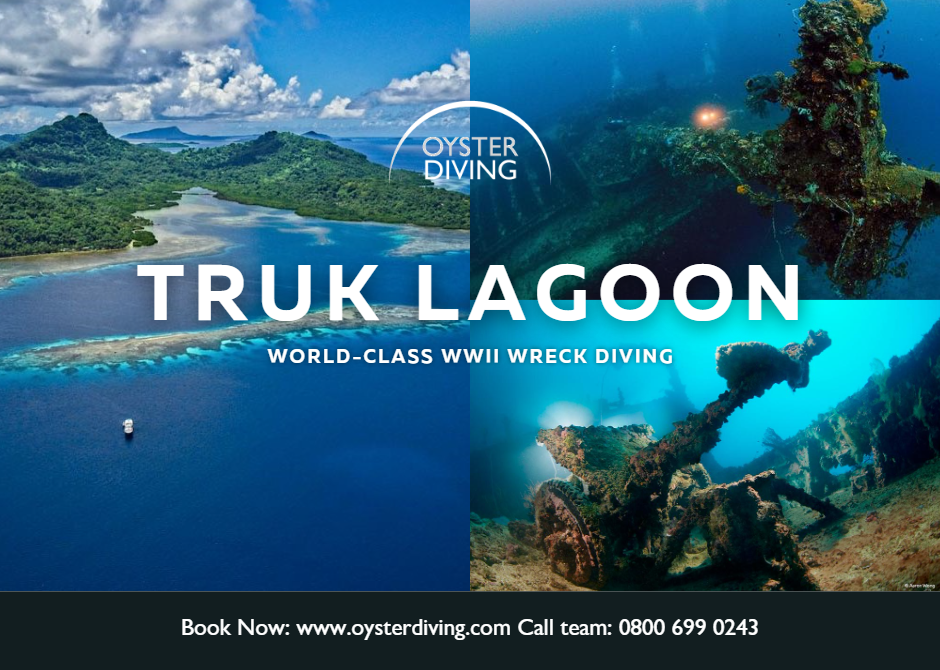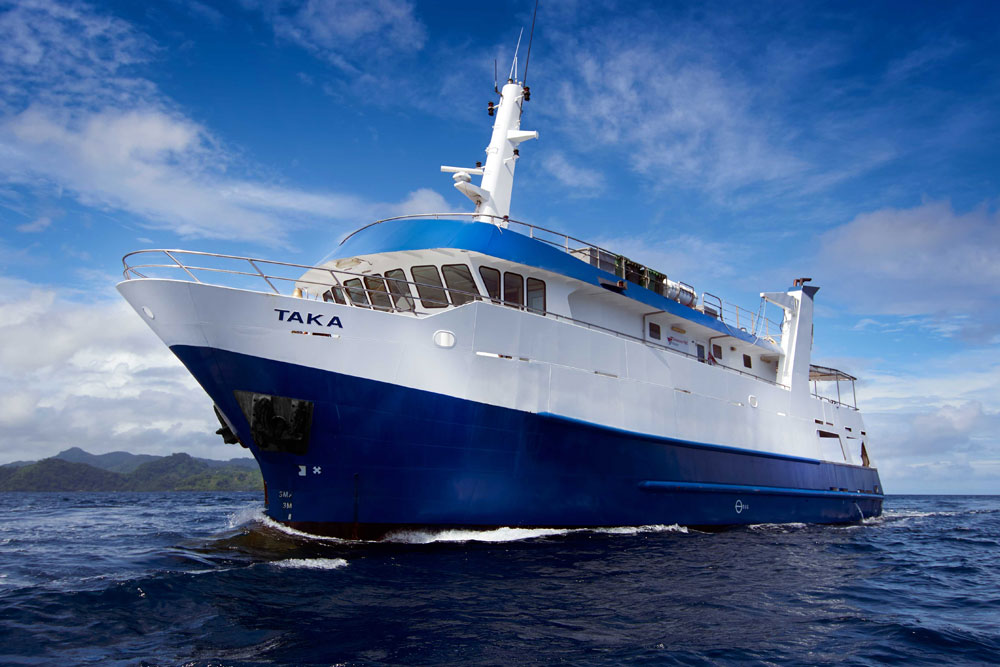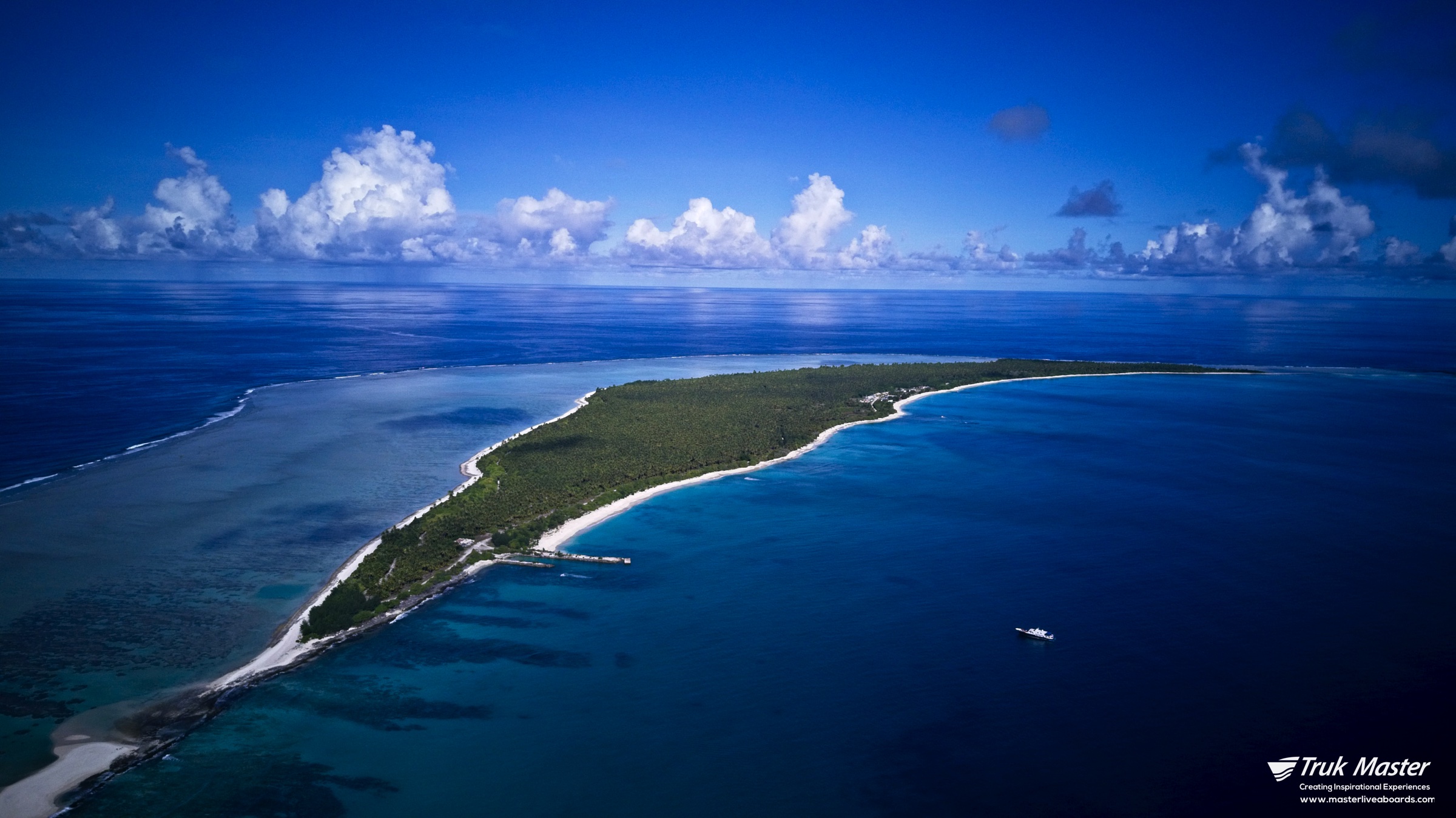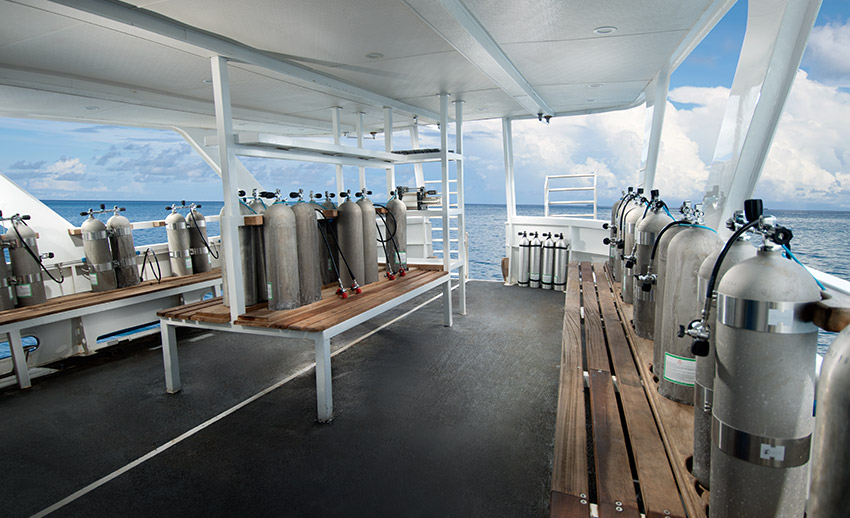Truk Lagoon, Liveaboard Diving Holiday
Japanese WWII Wreck Diving
17th to 25th January 2028

The Ultimate Wreck Diving Holiday – Truk Lagoon
Truk Lagoon is the world’s greatest underwater museum and undisputed wreck diving capital of the world, making it the ultimate diving holiday for heavy metal fans.
Hidden beneath the crystal-clear waters of this remote Pacific paradise lies a hauntingly beautiful time capsule. There are over 60 WWII wrecks of ships, planes, and even a submarine, preserved within a sheltered coral reef lagoon.
Once Japan’s main naval base in Micronesia, Truk was the site of Operation Hailstone — their version of Pearl Harbor. Today, its underwater graveyard offers diving experiences like no other, making it perfect for a Truk Lagoon diving holiday. The wrecks rest at a variety of depths and are ideal for Advanced Open Water divers and beyond. From engine rooms and torpedo holds to sunken fighter planes draped in soft corals, every dive in Truk Lagoon is an exploration of history, mystery, and marine life.


The Ultimate Liveaboard Experience – Dive in Style with Pacific Master
Purpose-built for divers, Pacific Master offers the ultimate liveaboard adventure, perfect for those on a Truk Lagoon diving holiday.
With 12 well appointed cabins for up to 20 guests, you’ll enjoy air conditioned lounges, gourmet meals, and stunning sea views from the sunny top deck. The expansive dive deck features individual stations, freshwater showers, and a dedicated camera area. It is perfect for photographers.
Whether you’re diving legendary wrecks or vibrant reefs, Pacific Master delivers world-class service and unforgettable underwater adventures during your Truk Lagoon diving holiday.
Prices
Liveaboard prices are:
– Twin share standard cabin £2,670pp
– Single standard cabin £2,770pp
– Double stateroom cabin £3,140pp
Payment Plan:
- Non-refundable deposit £500
- Payment 2 – £750 1st January 2027
- Balance – 1st November 2027
- Flights and accommodation paid at the time of booking (approx 9-12 months prior to departure)
Price includes 8 nights accommodation, all-meals, 3 dives per day (except for tech divers) and embarkation transfer.
Not included flights to/from the UK, any additional accommodation depending on the flight times / route, alcohol, crew tips and any visas.


Pacific Master Liveaboard
This specially crafted liveaboard was meticulously designed to cater to divers, ensuring an unparalleled diving holiday experience at Truk Lagoon. This vessel, with its steel hull, is equipped with a seasoned crew. It also has a proficient dive team and skilled chefs committed to delivering top-notch service.
It is recommended that you have at least the Deep Specialty and Nitrox certifications, SMB/reel, computer and dive torch. Please ensure you have read our holiday terms and conditions.
- The Name: "Chuuk" translates to "high mountains" in the local Chuukese language, a fitting descriptor for the region's landscape. The prominent Tonnachau Mountain greets visitors upon arrival at Chuuk International Airport.
- Least Visited: Due to its remote location, Chuuk ranks among the least visited countries globally, according to the United Nations World Tourism Organization. Its annual visitors, predominantly divers, number less than 19,000, making it a hidden gem.
- Legend of Wonip: Chuuk boasts its own folklore, including the legend of Wonip (or Wanip), recounting the discovery of a sunken island by five brothers. This tale lends its name to an actual island in Chuuk Lagoon.
- Political Chess: Throughout history, Chuuk has been subject to various colonial powers, including Spain, Germany, Japan, and the United States, shaping its political landscape and alliances.
- Lagoon of Lost Ships: Truk Lagoon gained international fame after Jacques Cousteau's exploration in 1969, documented in his series "Undersea World of Jacques Cousteau." This vast underwater graveyard holds remnants of World War II, including the iconic wreck of the Aikoku Maru.
- Operation Christmas Drop: A humanitarian mission initiated by the US Air Force, Operation Christmas Drop delivers essential supplies to remote Micronesian islands annually, showcasing a blend of military training and aid delivery.
- The Million Dollar Wreck: Among Chuuk's renowned wrecks is the San Francisco Maru, colloquially known as "The million dollar wreck," owing to its valuable cargo of armaments and machinery.
- Eco Concerns: The sunken ships in Truk Lagoon pose an environmental threat due to potential oil leaks. Efforts are underway to assess and mitigate the impact on the region's biodiversity and economy.
- Traditional Marriage Practices: Chuukese marriage traditions involve a series of rituals and ceremonies, emphasizing compatibility and communal support between families.
- Budget Custom: Embedded in Chuukese etiquette is the "budget" custom, signifying a communal sharing of resources. This practice underscores the culture's emphasis on collective welfare and familial bonds.
Diving Facilities:
- Diving Courses: Not available
- Equipment Rental: Available
- Nitrox Membrane: Yes
- Rebreather Friendly: Yes
- Tec Diving Friendly: Yes
- Charging Station: Available
- Photography Friendly: Yes
- Compressors: 3
- Tenders: 2
Technical Details:
- Length: 30 meters
- Width: 8 meters
- Engines: 1800HP V12
- Generators: 3
- Hull: Steel
- Fresh Water Maker
- Water Storage: 16 tonnes
Safety Measures:
- First Aid: Available
- First Aiders: Onboard
- Emergency Oxygen: Yes
- Oxygen Administrators: Onboard
- Life Jackets: Provided
- Life Rafts: Available
- VHF Ship to Tender Radios: Yes
- Smoke Detectors: Installed
- Fire Fighting Equipment: Provided
Pacific Master Room Types
Premium Double Cabin: Positioned on the upper deck, this expansive cabin presents magnificent views and comes with ensuite facilities.- Deck: Upper Deck
- Bedding: Double Bed
- Max. occupancy: 2
- Ensuite: Yes
- Air-conditioning: Yes
- No. of cabins: 1
- Ensuite bathroom
- Individually controlled air-conditioning
- Bathrobes
- Extra towels
- Deck: Upper deck
- Bedding: 1 x Double bed and 1 x Single bed
- Max. occupancy: 2
- Ensuite: Yes
- Air-conditioning: Yes
- No. of cabins: 4
- Ensuite bathroom
- Individually controlled air-conditioning
- Bathrobes
- Extra towels
- Deck: Upper deck
- Bedding: Twin beds
- Max. occupancy: 2
- Ensuite: Yes
- Air-conditioning: Yes
- No. of cabins: 1
- Ensuite bathroom
- Individually controlled air-conditioning
- Bathrobes
- Extra towels
- Deck: Lower deck
- Bedding: Twin beds
- Max. occupancy: 2
- Ensuite: No
- Air-conditioning: Yes
- No. of cabins: 2
- Centrally controlled air-conditioning
- Bathrobes
- Extra towels
- Deck: Lower deck
- Bedding: Single bed
- Max. occupancy: 1
- Ensuite: No
- Air-conditioning: Yes
- No. of cabins: 4
- Centrally controlled air-conditioning
- Bathrobes
- Extra towels
Intinerary
7 night Lagoon Itinerary
Exploring the wrecks of the WWII Japanese Imperial Navy fleet in Truk Lagoon offers divers a unique opportunity to step back in time and witness history beneath the waves. The diversity of wrecks, ranging from merchant vessels to fortified ships carrying crucial supplies for the war effort, provides a fascinating glimpse into the events of Operation Hailstone and its impact on the region.
The presence of everyday items such as bottles, cooking utensils, and personal belongings within the wrecks adds a poignant layer to the diving experience, serving as a reminder of the human stories behind these sunken vessels. It’s a humbling experience to encounter these artifacts and reflect on the lives lost during this pivotal moment in history.
With depths ranging from 18 meters to 64 meters, divers of varying experience levels can explore these wrecks, each offering its own unique set of challenges and discoveries. Whether it’s the eerie beauty of a sunken shipwreck or the thrill of uncovering hidden relics, diving in Truk Lagoon promises an unforgettable adventure for those seeking to delve into the mysteries of the past beneath the ocean’s surface.
- Light Breakfast followed by a briefing and Dive 1
- Full Breakfast, relaxation period, briefing and Dive 2
- Lunch, relaxation period, briefing and Dive 3
- Snack relaxation period, briefing and Dive 4, where possible*
- Dinner
Cost includes
Return transfers from local airport to the vessel on days of embarkation and disembarkation Full board accommodation (based on double occupancy) Tea Coffee Juices & soft drinks Up to 3 dives daily at Truk Single 11.1 litre (80cf) aluminium tanks (commonly called 12ltr) Weight belts and weights";s:14:"excludes_title";s:13:"Cost excludes";s:13:"cost_excludes";s:638:"Obligatory surchargesNot Included
All guests are required to have diving and travel insurance Departure Tax : 30 USD per trip, to be paid at the airport Marine, park and port fees : 250 USD per trip, to be paid on boardine, park and port fees may be subject to change, without notice: Marine & Port Fees (payable onboard only) - $240 to be paid on board Departure tax - $30 paid at the airport Flights Cylinders Gases (charged per litre, per fill - payable on board only) Sofnolime (required quantity MUST be pre-ordered. Cost is payable on board only) Alcoholic beverages Laundry Crew crew gratuities Equipment rental show more Extra services show more Gases Technical gearGetting to Bikini Atoll and general information
Getting there and away… Our itinerary is built around the United Airlines flight from Honolulu, Hawaii that serves both Kwajalein and Majuro. Depending on your itinerary, we highly recommend you use this flight to get to and from Kwajalein and/or Majuro. Passengers travelling from the Marshall Islands are required to pay an airport departure tax, for Kwajalein this is currently 20US$. This varies from airport to airport and must be paid in US$.
On arrival… No visa is required for entering the Marshall Islands for US citizens, EU countries, Canada and most other Western countries. Nevertheless, we recommend our guests to check for any updates and changes with their nearest Marshall Islands embassy or consulate. Please make sure that your passport is valid for at least 6 months beyond the period you intend to stay in the Marshall Islands. If you are traveling with medication, please ensure to bring your physician’s prescription with you. Please ensure you have a printed copy of the Master Liveaboards Sponsor Letter on hand when arriving in Kwajalein. Important information on arrival procedures in Kwajalein can be found here.
Staying there… The local currency in the Marshall Islands is the US Dollar (US$). Major businesses will accept credit cards; traveller’s cheques are accepted by banks and larger businesses. The number of ATMs on the islands is very limited, so we recommend bringing a sufficient amount of USD in cash, preferably in smaller denominations.
Climate and weather… The climate of the Marshall Islands is a tropical climate, with temperatures averaging between 27 and 29C (80-84F) all year round, with some trade winds and a light cooling down in the evening. Generally, the northern islands tend not to receive as much rainfall as the southern islands.
Time zone… The local time in the Marshall Islands is 12 hours ahead of UTC (GMT).
Health… In the Marshall Islands, medical care is very basic with the ‘best’ medical facility in Majuro. Any form of treatment other than basic requires evacuation. Normal precautions should be taken with food and it is advisable to drink bottled water only. No vaccinations are required before entering the Marshall Islands, however; we recommend consulting your doctor for updated information well before departure.
Radioactive radiation to which divers are exposed from the shipwrecks is negligible since water acts as an excellent insulator. Divers are safe, as long as they do not try to grab souvenirs from the wrecks. Pilfering is forbidden and hazardous.
Travel Advisories… We recommend that you book your international flight to and from Kwajalein Airport, which is served by United Airlines 3 times per week from Hawaii and takes around 7 hours. (The HNL – MAJ – KWA flight leaves on Monday, Wednesday, Friday, so generally, you will have to leave the day before that (Sunday, Tuesday, Thursday) from Los Angeles (LAX) or San Francisco (SFO) to make the connection.) Ideally, you arrive in Honolulu one day in advance of your flight to Kwajalein as this flight departs early in the morning. Keep in mind you will be crossing the date line traveling to Kwajalein Atoll. There is also a flight from Guam arriving at Kwajalein, however; we have scheduled our itinerary around the Honolulu flight.
Getting to Truk and general information
Getting there and away… M/V Truk Master embarks and disembarks at Chuuk International Airport. Book your international flight in and out of Chuuk International Airport (TKK) on Weno Island. Disembarkation at the end of the cruise will be just before 10 am. Most flights to Chuuk International Airport (TKK) require transit via Hawaii or Guam. Passengers travelling within the Federated States of Micronesia (FSM) are required to pay an airport departure tax for Chuuk, which is currently 30 US$.
Travel Advisories… Most flights to Chuuk International Airport (TKK) require transit via Guam or Hawaii, which are part of the United States. All non-US citizens must obtain a US visa or Electronic System of Travel Authorization (ESTA) prior to travel. Citizens of 37 countries, including most European nations, Australia, New Zealand, and Japan are eligible for the ESTA and should apply online at least 72 hours prior to travel. An ESTA is valid for 2 years and allows for multiple entries into US territories within that period. Guests without a visa or ESTA may be denied boarding.
On arrival… Passport holders of most western countries may obtain a visa on arrival which allows stays up to 30 days, meanwhile, travelers from the United States may obtain a tourist visa for up to 1-year stay. Please make sure that your passport has a validity of at least 4 months upon arrival into Chuuk and you are also required to show a confirmed ticket to leave Chuuk, or any country you are transiting through, prior to boarding your flight. For more information please visit the Chuuk Visitor’s Bureau.
Staying there… The local currency is the US Dollar (US$). The majority of established hotels, shops and restaurants accept major credit cards. However, smaller establishments are likely to only accept cash payments. ATMs are available however guests are advised to exchange money prior to arrival and to ensure you have small denominations on hand. We work with a number of hotels and resorts. Should you wish to extend your stay in Truk, our team will be pleased to assist you.
Climate and weather… Truk, as part of the Federated States of Micronesia (FSM) is a tropical country and the climate is fairly even all year round. The average high is 30°C (86°F) whilst the average low is 25°C (77°F) throughout the year. The more humid climate is during the summer months (Jun-Sept) whilst trade winds come mainly from the northeast between December and June.
Time zone… The local time is 10 hours ahead of UTC (GMT).
Health… Health care is readily available in the FSM and a major hospital is located within each of the states. There are no tropical diseases, however, to prevent stomach ailments we recommend travelers follow normal precautions with food and drink bottled water only. Please consult your doctor or nearest health care professional for up-to-date medical travel information well before departure. Visitors arriving from countries that are affected by Cholera or Yellow Fever must show proof of immunization upon arrival.
What dive experience level is recommended for Bikini Liveaboard trips?
Diving on the Bikini wrecks is respectfully recommended for technical divers only with a minimum of PADI Tec 50 level or equivalent, with wreck experience, as the average depth of the wrecks is around 50 meters (150 ft). To get the most out of your dives in Bikini Atoll, highly recommended are:
TDI – Advanced Nitrox & Deco Procedures
IANTD – Tech Nitrox
NAUI – Tech Nitrox & Deco Techniques
ANDI – Technical Nitrox
















